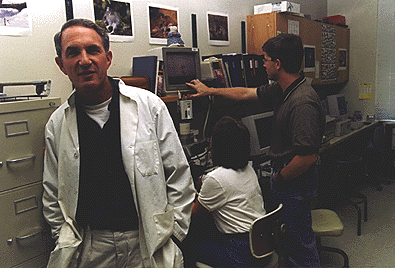![[Currents header graphic]](/homeart/currents_header.gif)
![[Currents header graphic]](/homeart/currents_header.gif)
August 4, 1997

|
|
Gary Silberstein, with colleagues Phyllis Strickland and Michael Lewis
|
By Robert Irion
A gene linked to the most common abdominal cancer in children also may contribute to the development of breast cancer, according to a study at UCSC and Oregon Health Sciences University.
A team led by UCSC biologist Gary Silberstein found evidence that a gene called WT1, which prevents abnormal cell division in the kidney, also is active in healthy breast tissues. However, the gene was silent, or nearly so, in two-thirds of the cancerous breast tissues examined by the team. These tissues included tumors in their earliest stages of growth--just a few cells beginning to run amok.
The study is the first to make a connection between breast cancer and WT1, so named because of its role in the childhood kidney cancer called Wilm's tumor. The team published its research in the July 22 issue of the Proceedings of the National Academy of Sciences.
"It is not inconceivable that the loss of WT1 function is an early event in the progression to breast cancer," said Silberstein, an associate research biologist at UCSC. "This really is a brand-new finding, a once-in-a-lifetime connection that should open new avenues of breast-cancer research."
Silberstein emphasized that the research will not lead to new medical or preventive treatments in the near future. However, by shedding light on the cellular machinations of diseased breasts, it may give researchers a new strategy as they attempt to devise "gene therapy" approaches to restore the normal functions of genes that stunt the growth of tumors.
Silberstein led the study in the laboratory of Charles Daniel, research professor of biology at UCSC. Other coauthors included Charles T. Roberts, Jr., professor of pediatrics at Oregon Health Sciences University and an expert on Wilm's tumor, and UCSC researchers Katharine Van Horn and Phyllis Strickland.
The scientists received samples of both healthy and diseased breast tissues via Daniel's ongoing collaboration with physicians at Dominican Santa Cruz Hospital, most notably pathologist Dr. Kelly O'Keefe and surgeon Dr. John Snyder. All tissues were obtained with the informed consent of patients. Other samples came from the University of Michigan's Breast Tissue Bank.
WT1, it appears, is among a chain of genes that helps govern the production of important hormones, called growth factors, in both the kidney and the breast. The growth factors are part of a fine-tuned hormonal system of checks and balances that controls the extent to which cells proliferate. WT1's key targets in the cell are hormones known as insulin-like growth factors (IGFs) and transforming growth factor beta (TGF-beta). Research in the labs of Daniel and others has shown that both IGFs and TGF-beta are crucial to regulating growth in mammary glands.
When WT1 does its job, it instructs the cell to churn out proteins that manage the amount of IGFs and TGF-beta. "WT1 essentially is a middle-management gene," Silberstein said. "It's expressed in an exceedingly complex way--it's basically four genes in one. But there is a direct connection between WT1 and factors that control the growth of breast tissues."
The researchers examined normal tissues from the breasts of six patients who had undergone breast-reduction surgery at Dominican Hospital. The WT1 protein was present in cells from all of these patients, indicating that the gene was active and functioning properly.
Then, the team looked at tissues excised from 21 breast-cancer patients, ranging in age from 29 to 88 years. In 40 percent of all the tumors studied, the researchers could not detect the WT1 protein--the gene, for unknown reasons, had malfunctioned or fallen silent. In another 28 percent of the tumors, most of the cells lacked the WT1 protein.
"The story is complex, because it has been difficult to find a single molecular or genetic defect that is common to all the various forms of breast tumors," said Roberts, who directs the Doernbecher Pediatric Research Laboratories at OHSU. "Finding abnormal WT1 activity in several types of breast cancer suggests that defects in WT1 action may underlie many forms of breast cancer."
Curiously, the WTI gene was active in a highly malignant subset of advanced breast tumors, called estrogen receptor-negative tumors. However, the researchers also detected another well-known tumor suppressor gene, called p53, in these malignant cells. Those two genes can interact, so p53 may interfere with WT1's normal function.
There is no evidence of a mutation in the WT1 gene, Silberstein said, so WT1 would not be a factor in hereditary breast cancers. No relationship is yet evident between the WT1 gene and the previously discovered BRCA I and II genes, which play a role in hereditary forms of breast cancer. Those cases comprise 5 to 10 percent of all breast cancers.
Silberstein, Daniel, and their UCSC colleagues are completing a study of the developmental regulation of WT1 in the mammary glands of mice. Early results support the findings from human tissues: the gene's products are absent in precancerous tissues but present in more mature tumors.
The research was supported by grants from the National Institutes of Health to the laboratories of both Daniel and Roberts.